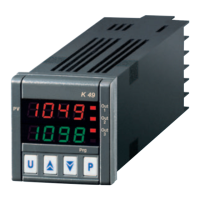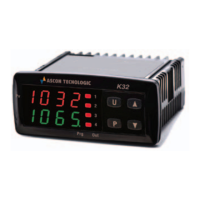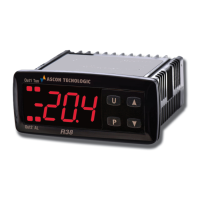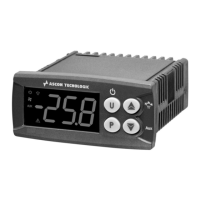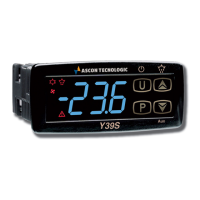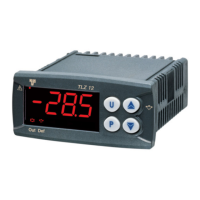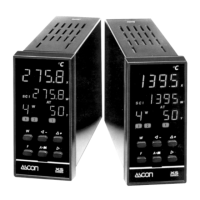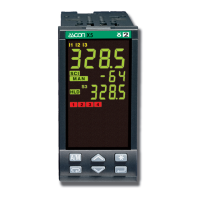Ascon Tecnologic - KM3 - L - ENGINEERING MANUAL - PAG. 7
[8] di.A - Digital Inputs Action
Available: Always.
Range: 0 = DI1 Direct action (transition from ;open to
close)
1 = DI1 Reverse action (transition from closed
to open).
]out Group - Output parameters
[9] o1.t - Out 1 type
Available: When the out 1 is present.
Range: 0-20 0 to 20 mA;
4-20 4 to 20 mA;
0-10 0 to 10 V;
2-10 2 to 10 V.
[10] o1.F - Out 1 function
Available: Always.
Range: • When the out 1 is a linear output:
nonE =
Output not used.
r.inP = Measured value Analog retransmission.
r.Err = Analog retransmission of the measured
error (PV-SP);
r.SP = Analog retransmission of the operative set
point;
r.SEr = Analog retransmission of a value coming
from serial link;
[11] A.o1L - Initial scale value of the analog
retransmission
Available: When Out 1 is present
Range: -1999 to [12] Ao1H.
[12] A.o1H
- Full scale value of the analog
retransmission
Available: When Out 1 is present.
Range: [11] Ao1L to 9999.
[13] o3F - Out 3 function
Available: When the instrument has out 3 option.
Range: nonE = Output not used. With this setting the status
of the this output can be driven directly
from serial link;
AL = Alarm output;
or.bo = Out-of-range or burn out indicator;
P.FAL = Power failure indicator;
bo.PF = Out-of-range, burn out and Power failure
indicator;
[14] o3.AL - Alarms linked up with Out 3
Available: When [13] o3F = AL.
Range: 0 to 15 with the following rule:
+1 = Alarm 1;
+2 = Alarm 2;
+4 = Sensor break (burn out);
+8 = Overload on Out 4 (short circuit on OP 4).
Example: Setting 3 (2+1) the output will be driven by the
alarm 1 and 2 (OR condition).
[15] o3Ac - Out 3 action
Available: when [13] o3F is different from “nonE”.
Range: dir = Direct action;
rEU = Reverse action;
Notes:
Notes: 1. Direct action: the output repeats the status of
the driven element. Example: the output is an
alarm output with direct action. When the alarm is
ON, the relay will be energized (logic output 1).
2. Reverse action: the output status is the opposite
of the status of the driven element. Example:
the output is an alarm output with reverse
action. When the alarm is OFF, the relay will be
energized (logic output 1). This setting is usually
named “fail-safe” and it is generally used in
dangerous process in order to generate an alarm
when the instrument power supply goes OFF or
the internal watchdog starts.
[16] o4F - Out 4 function
Available: Always.
Range: nonE = Output not used. With this setting the status
of the this output can be driven directly
from serial link.
AL = Alarm output;
or.bo = Out-of-range or burn out indicator;
P.FAL = Power failure indicator;
bo.PF = Out-of-range, burn out and Power failure
indicator;
on = Output ever ON (it is used as auxiliary
power supply for TX).
[17] o4.AL - Alarms linked up with Out 4
Available: When [16] o4F = AL.
Range: 0 to 15 with the following rule.
+1 = Alarm 1;
+2 = Alarm 2;
+4 = Sensor break (burn out);
+8 = overload on Out 4 (short circuit on OP4).
For more details see [14] o3.AL parameter.
[18] o4Ac - Out 4 action
Available: When [16] o4F is different from “nonE”.
Range: dir = Direct action;
rEU = Reverse action;.
For more details see [15] o4.Ac parameter.
]AL1 Group - Alarm 1 parameters
[19] AL1t - Alarm 1 type
Available: Always.
Range: • When one or more outputs are programmed as
control output:
nonE = Alarm not used;
LoAb = Absolute low alarm;
HiAb = Absolute high alarm;
LHAo = Absolute band alarm with alarm indication
out of the band;
LHAi = Absolute band alarm with alarm indication
inside the band;
SE.br = Sensor break;
LodE = Deviation low alarm (relative);
HidE = Deviation high alarm (relative);
LHdo = Relative band alarm with alarm indication
out of the band;
LHdi = Relative band alarm with alarm indication
inside the band.
Notes: 1. The relative and deviation alarms are “relative”
to the operative set point value.
